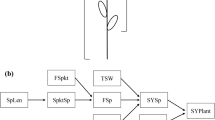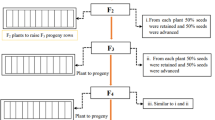Summary
Mean seed weight data were obtained from the F1 and F2 of a six-by-six diallel cross with flax (Linum usita-tissimum L.). Pronounced reciprocal differences appeared in the F1, but had largely disappeared by the F2. The genetic control of mean seed weight was examined using two types of analysis of variance. The models underlying both analyses were fitted to the data by matrix methods supplying weighted least-squares estimates of the parameters in the models. Weights, the use of which dealt with the problem of variation in the reliability of means, were the reciprocals of the variances of individual cell (cross/self) means in the diallel data table. Elimination of redundant parameters supplied the minimum adequate models for each analysis type. Dominance was apparently masked by the large transient maternal effects in the F1, but surfaced in the F2, where dominance was towards larger mean seed weight. This may be coupled with findings elsewhere of possible advantages for larger seed weights to speculate on a role in preserving infrequent hybrid progeny among inbreeding (flax) species. Maternal effects producing larger seed size, plus dominance with the same result might be valuable, in conjunction with growth and competitive advantages conferred by larger seed, in preventing early elimination of rare hybrids.
Similar content being viewed by others
References
Allard RW, Jain SK, Workman PL (1968) The genetics of inbreeding populations. Adv Genet 14:55–131
Anton H (1977) Elementary linear algebra. Wiley, New York
Bartlett MS (1937) Some examples of statistical methods of research in agriculture and applied biology. J R Stat Soc Suppl 4:137–183
Cavalli LL (1952) An analysis of linkage in quantitative inheritance. In: Reeve ECR, Waddington CH (eds) Quantitative inheritance. Her Majesty's Stationary Office, London
Dillman AC (1946) Classification of flax varieties. USDA Techn Bull No. 1054
Draper NR, Smith H (1968) Applied regression analysis. Wiley, New York
Durrant A (1965) Analysis of reciprocal differences in diallel crosses. Heredity 20:573–607
Durrant A (1968) Phenotype analysis of diallel crosses. Heredity 24:541–560
Durrant A (1971) Induction and growth of flax genotrophs. Heredity 27:277–298
Fieldes MA, Tyson H (1984) Possible post-translational modification and its genetic control, in flax genotroph isozymes. Biochem Genet 21:99–114
Griffing B (1956) Concept of general and specific combining ability in relation to diallel crossing systems. Aust J Biol Sci 9:463–493
Harper JL, Lovell PH, Moore KG (1970) The shapes and sizes of seeds. Ann Rev Ecol Syst 1:327–356
Harvey WR (1960) Least squares analysis of data with unequal sub-class numbers. Bull ARS-20-8, USDA
Hayman BI (1954a) The analysis of variance of diallel tables. Biometrics 10:235–244
Hayman BI (1954b) The theory and analysis of diallel tables. Genetics 39:789–809
Jeswani LM, Murty BR (1963) Components of association for some yield factors in linseed. Indian J Genet 25:163–175
Khan MA (1963) Genetic analysis of varietal differences within Linum usitatissimum (flax and linseed). PhD Thesis, University of Wales
Manner R (1956) Studies on seed-setting and seed yield in oil flax. Meddelande Från Gullåkers Växtförädlingsanstalt, Hammenhög Nr. 12. Paper presented at Faculty of Agriculture and Forestry, University of Helsinki, Finland
Mather K, Jinks JL (1982) Biometrical Genetics, 3rd. ed. Chapman and Hall, London
Morley-Jones R (1965) Analysis of variance of the half diallel table. Heredity 20:117–121
Smith WE, Fitzsimmons JE (1964) Maternal inheritance of seed weight in flax (Linum usitatissimum). Can J Genet Cytol 6:244
Tyson H (1973) Cytoplasmic effects on plant weight in crosses between flax genotypes and genotrophs. Heredity 30: 327–340
Author information
Authors and Affiliations
Additional information
Communicated by A. R. Hallauer
Rights and permissions
About this article
Cite this article
Tyson, H. Genetic control of seed weight in flax (Linum usitatissimum) and possible implications. Theoret. Appl. Genetics 77, 260–270 (1989). https://doi.org/10.1007/BF00266196
Received:
Accepted:
Issue Date:
DOI: https://doi.org/10.1007/BF00266196




